

Compact Muon Solenoid
LHC, CERN
| CMS-HIN-21-009 ; CERN-EP-2022-098 | ||
| Observation of $ \tau $ lepton pair production in ultraperipheral lead-lead collisions at $ \sqrt{\smash[b]{s_{_{\mathrm{NN}}}}} = $ 5.02 TeV | ||
| CMS Collaboration | ||
| 10 June 2022 | ||
| Phys. Rev. Lett. 131 (2023) 151803 | ||
| Abstract: We present an observation of photon-photon production of $ \tau $ lepton pairs in ultraperipheral lead-lead collisions. The measurement is based on a data sample with an integrated luminosity of 404 $\mu$b$^{-1}$ collected by the CMS experiment at a center-of-mass energy per nucleon pair of $ \sqrt{\smash[b]{s_{_{\mathrm{NN}}}}} = $ 5.02 TeV. The $ \gamma\gamma\to\tau^{+}\tau^{-} $ process is observed for $ \tau^{+}\tau^{-} $ events with a muon and three charged hadrons in the final state. The measured fiducial cross section is $ \sigma(\gamma\gamma\to\tau^{+}\tau^{-}) = $ 4.8 $ \pm $ 0.6 $ \pm $ 0.5 $\mu$b, where the second (third) term corresponds to the statistical (systematic) uncertainty in $ \sigma(\gamma\gamma\to\tau^{+}\tau^{-}) $, in agreement with leading-order QED predictions. Using $ \sigma(\gamma\gamma\to\tau^{+}\tau^{-}) $, we estimate a model-dependent value of the anomalous magnetic moment of the $ \tau $ lepton of $ a_{\tau}= $ 0.001 $ ^{+0.055}_{-0.089} $. | ||
| Links: e-print arXiv:2206.05192 [hep-ex] (PDF) ; CDS record ; inSPIRE record ; HepData record ; Physics Briefing ; CADI line (restricted) ; | ||
| Figures | Summary | Additional Figures | References | CMS Publications |
|---|
| Figures | |

png pdf |
Figure 1:
Left: Transverse momentum of the muon originating from the ${\tau _{\mu}}$ candidate. Middle: Invariant mass of the three pions forming the ${\tau _{\text {3prong}}}$ candidate. Right: ${\tau^{+} \tau^{-} }$ invariant mass. In all plots, the signal component (magenta histogram) is stacked on top of the background component (green histogram), considering their initial normalizations, as described in the text. The sum of signal and background is displayed by a blue line and the shaded area shows the statistical uncertainty. The data are represented with black points and the uncertainty is statistical only. The lower panels show the ratios of data to the signal-plus-background prediction, and the shaded bands represent the statistical uncertainty in the prefit expectation. |

png pdf |
Figure 1-a:
Transverse momentum of the muon originating from the ${\tau _{\mu}}$ candidate. The signal component (magenta histogram) is stacked on top of the background component (green histogram), considering their initial normalizations, as described in the text. The sum of signal and background is displayed by a blue line and the shaded area shows the statistical uncertainty. The data are represented with black points and the uncertainty is statistical only. The lower panel shows the ratio of data to the signal-plus-background prediction, and the shaded band represents the statistical uncertainty in the prefit expectation. |
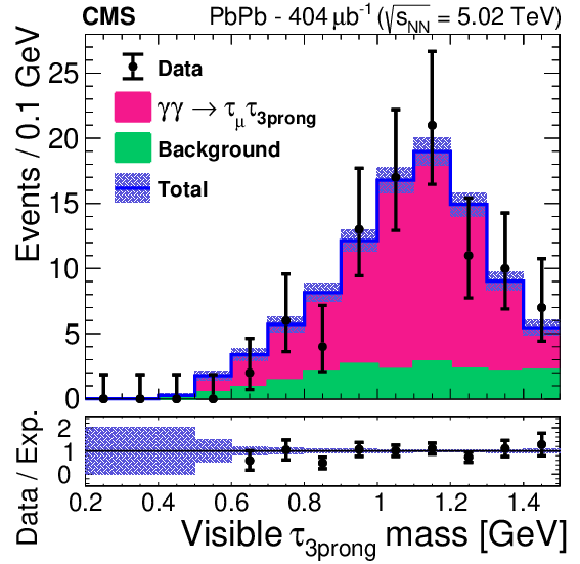
png pdf |
Figure 1-b:
Invariant mass of the three pions forming the ${\tau _{\text {3prong}}}$ candidate. The signal component (magenta histogram) is stacked on top of the background component (green histogram), considering their initial normalizations, as described in the text. The sum of signal and background is displayed by a blue line and the shaded area shows the statistical uncertainty. The data are represented with black points and the uncertainty is statistical only. The lower panel shows the ratio of data to the signal-plus-background prediction, and the shaded band represents the statistical uncertainty in the prefit expectation. |
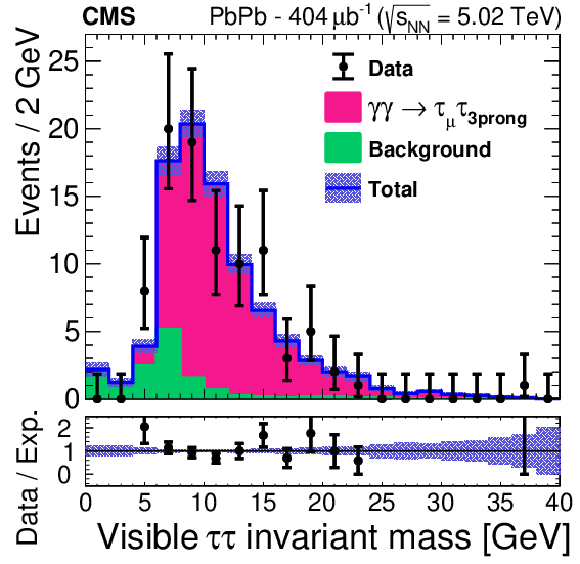
png pdf |
Figure 1-c:
${\tau^{+} \tau^{-} }$ invariant mass. The signal component (magenta histogram) is stacked on top of the background component (green histogram), considering their initial normalizations, as described in the text. The sum of signal and background is displayed by a blue line and the shaded area shows the statistical uncertainty. The data are represented with black points and the uncertainty is statistical only. The lower panel shows the ratio of data to the signal-plus-background prediction, and the shaded band represents the statistical uncertainty in the prefit expectation. |

png pdf |
Figure 2:
Difference in azimuthal opening angle between the ${\tau _{\mu}}$ and $ {\tau _{\text {3prong}}} $ candidates. The data are represented by the points with the vertical bars showing the statistical uncertainties. The signal (background) contribution is given by the magenta (green) histogram, after the application of the fit procedure. The total is displayed by a blue line and the shaded area shows the combined statistical and systematic uncertainties. The lower panel shows the ratio of data to the signal plus background prediction, and the shaded band represents the total uncertainty in the postfit prediction. |
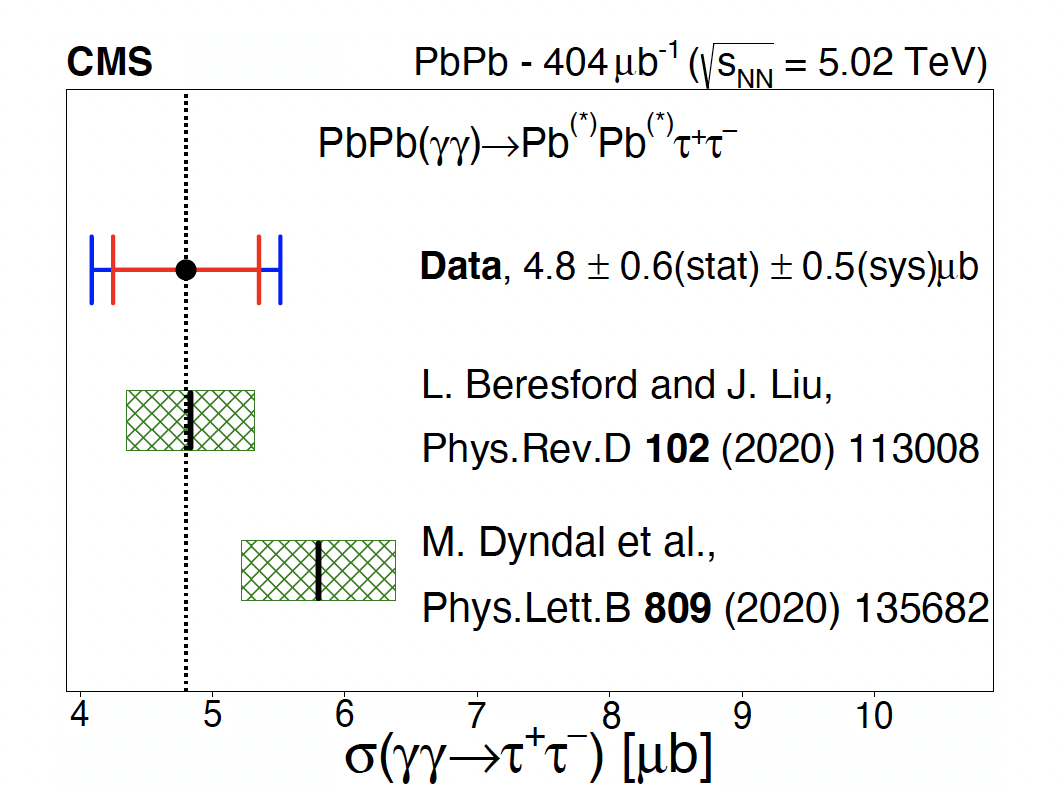
png pdf |
Figure 3:
The cross section, ${\sigma ({\gamma \gamma \to {\tau^{+} \tau^{-} }})}$, measured in a fiducial phase space region at $ {\sqrt {\smash [b]{s_{_{\mathrm {NN}}}}}} = $ 5.02 TeV. The theoretical predictions [3,4] are computed with leading-order accuracy in QED and are represented by the vertical solid lines that can be compared with the vertical dotted line representing this measurement. The outer blue (inner red) error bars surrounding the data point indicate the total (statistical) uncertainties, whereas the green hatched bands correspond to the uncertainty in the theoretical predictions as described in the main text. The potential electromagnetic excitation of the outgoing Pb ions is denoted by *. |
| Summary |
| In summary, an observation of $ \tau $ lepton pair production in ultraperipheral nucleus-nucleus collisions is reported. Events with a final state of one muon and three charged hadrons assumed to be pions are reconstructed from a lead-lead data sample with an integrated luminosity of 404 $\mu$b$^{-1}$ collected by the CMS experiment at $ \sqrt{\smash[b]{s_{_{\mathrm{NN}}}}} = $ 5.02 TeV in 2015. The statistical significance of the signal relative to the background-only expectation is far above five standard deviations. The cross section for the $ \gamma\gamma\to\tau^{+}\tau^{-} $ process, within a fiducial phase space region, is $ \sigma(\gamma\gamma\to\tau^{+}\tau^{-})= $ 4.8 $ \pm $ 0.6 $ \pm $ 0.5 $\mu$b, in agreement with leading-order quantum electrodynamics predictions. Using the measured cross section and its corresponding uncertainties, we estimate a model-dependent value of the anomalous magnetic moment of the $ \tau $ lepton of $ a_{\tau}= $ 0.001 $ ^{+0.055}_{-0.089} $. This measurement provides a novel experimental probe of the $ \tau $ anomalous magnetic moment using heavy ion collisions at the LHC. |
| Additional Figures | |

png pdf |
Additional Figure 1:
Event display of a candidate $\gamma \gamma \to \tau^{+} \tau^{-} $ event measured in PbPb UPC at CMS. The event is reconstructed as having a leptonic $\tau$ decay (red), $\tau \to \mu \nu _\mu \nu _\tau $, and a hadronic $\tau$ decay (yellow), $\tau \to \pi ^\pm \pi ^\mp \pi ^\pm \nu _\tau $. |
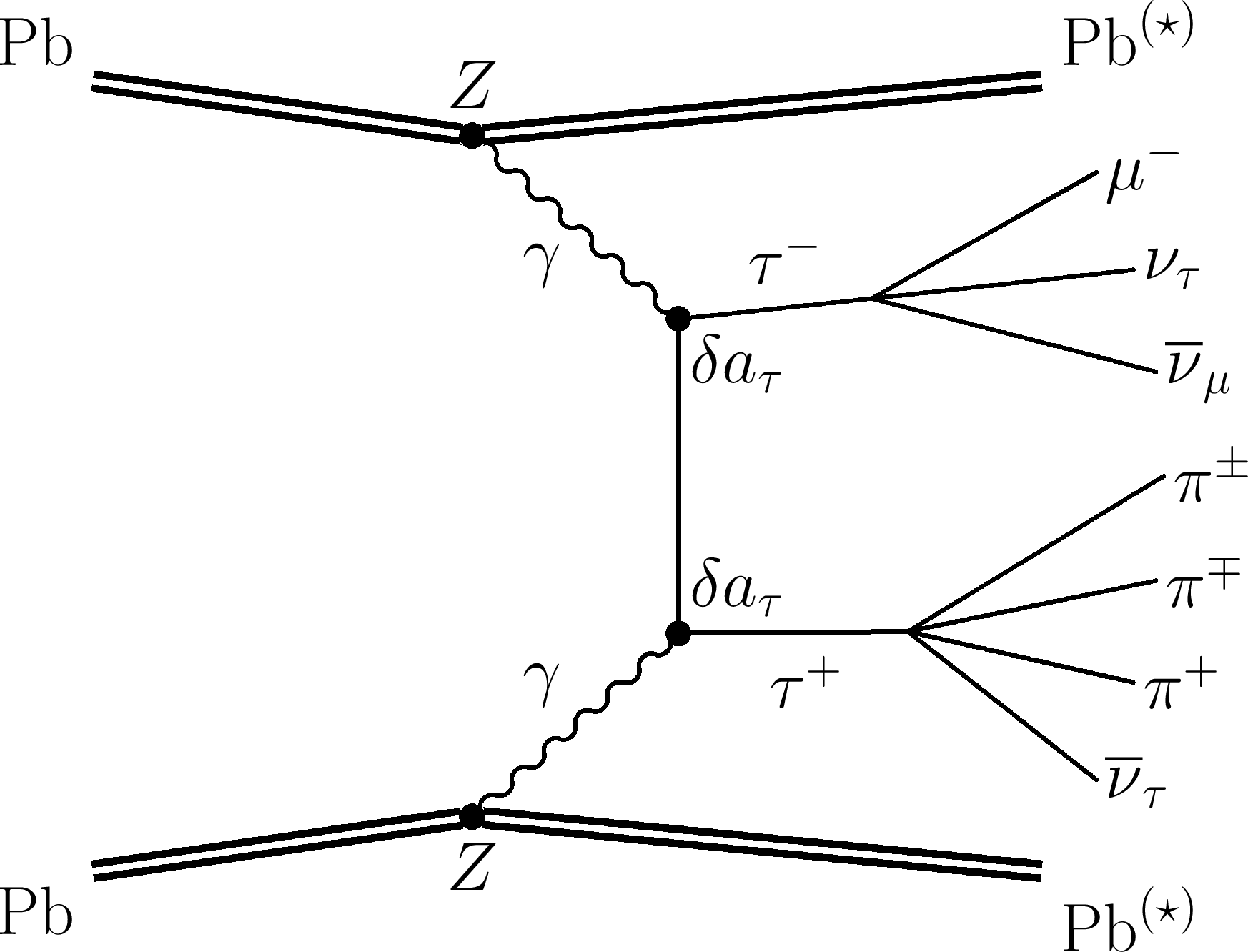
png pdf |
Additional Figure 2:
Leading-order QED diagram (and charge conjugate) for the photoproduction of a pair of $\tau$ leptons ${\gamma \gamma \to {\tau^{+} \tau^{-} }}$ in ultraperipheral PbPb collisions. The presence of $\gamma \tau \tau $ vertices gives sensitivity to the anomalous electromagnetic couplings of the $\tau$ lepton. A possible deviation of the anomalous magnetic moment $\delta a_\tau $ is illustrated in each vertex. The $\tau$ leptons are reconstructed in an observed final state involving one muon ($\mu $) and three charged particles assumed as pions ($\pi $), while neutrinos ($\nu $) escape undetected. The potential electromagnetic excitation of the outgoing Pb ions is denoted by *. |
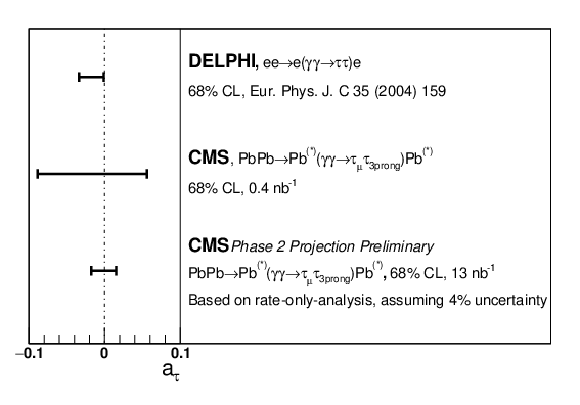
png pdf |
Additional Figure 3:
Comparison of the constraints on $a_\tau $ at 68% confidence level from this analysis and the DELPHI experiment at LEP [12]. The projection to the integrated PbPb luminosity expected from the High-Luminosity LHC program is included (using the same procedure described in the text, based on the parametrization from Ref. [3]). For the latter, we foresee a $\lesssim $ 4 ($ < $ 2) % systematic (statistical) uncertainty with the improvements originating from lepton and tracking reconstruction, and the knowledge of the integrated luminosity [57]. |
| References | ||||
| 1 | A. J. Baltz | The physics of ultraperipheral collisions at the LHC | PR 458 (2008) | 0706.3356 |
| 2 | F. del Aguila, F. Cornet, and J. I. Illana | The possibility of using a large heavy ion collider for measuring the electromagnetic properties of the $ \tau $ lepton | PLB 271 (1991) 256 | |
| 3 | L. Beresford and J. Liu | New physics and $ \tau$ $g{-}2 $ using LHC heavy ion collisions | PRD 102 (2020) 113008 | 1908.05180 |
| 4 | M. Dyndal, M. Klusek-Gawenda, M. Schott, and A. Szczurek | Anomalous electromagnetic moments of $ \tau $ lepton in $ \gamma\gamma\tau\tau $ reaction in PbPb collisions at the LHC | PLB 809 (2020) 135682 | 2002.05503 |
| 5 | R. H. Parker et al. | Measurement of the fine-structure constant as a test of the standard model | Science 360 (2018) 191 | 1812.04130 |
| 6 | L. Morel, Z. Yao, P. Cladé, and S. Guellati-Khélifa | Determination of the fine-structure constant with an accuracy of 81 parts per trillion | Nature 588 (2020) 61 | |
| 7 | Muon g${-}$2 Collaboration | Measurement of the positive muon anomalous magnetic moment to 0.46 ppm | PRL 126 (2021) 141801 | 2104.03281 |
| 8 | T. Aoyama et al. | The anomalous magnetic moment of the muon in the standard model | PR 887 (2020) 1 | 2006.04822 |
| 9 | S. Borsanyi et al. | Leading hadronic contribution to the muon magnetic moment from lattice QCD | Nature 593 (2021) 51 | 2002.12347 |
| 10 | M. Passera | Precise mass-dependent QED contributions to leptonic $ g{-}2 $ at order $ \alpha^2 $ and $ \alpha^3 $ | PRD 75 (2007) 013002 | hep-ph/0606174 |
| 11 | S. Eidelman and M. Passera | Theory of the $ \tau $ lepton anomalous magnetic moment | MPLA 22 (2007) 159 | hep-ph/0701260 |
| 12 | DELPHI Collaboration | Study of $ \tau $ pair production in photon-photon collisions at LEP and limits on the anomalous electromagnetic moments of the $ \tau $ lepton | EPJC 35 (2004) 159 | hep-ex/0406010 |
| 13 | Particle Data Group | Review of Particle Physics | PTEP 2020 (2020) 083C01 | |
| 14 | A. Crivellin, M. Hoferichter, and J. M. Roney | Towards testing the magnetic moment of the $ \tau $ at one part per million | 2021 | 2111.10378 |
| 15 | A. Crivellin and M. Hoferichter | Consequences of chirally enhanced explanations of $ (g{-}2)_{\mu} $ for $ \tilde{\mathrm{h}}\to\mu\mu $ and $ \mathrm{Z}\to\mu\mu $ | JHEP 07 (2021) 135 | 2104.03202 |
| 16 | ATLAS Collaboration | Observation of the $ \gamma\gamma\to\tau\tau $ process in PbPb collisions and constraints on the $ \tau $ lepton anomalous magnetic moment with the ATLAS detector | PRL 131 (2023) 151802 | 2204.13478 |
| 17 | CMS Collaboration | HEPData record for this analysis | link | |
| 18 | CMS Collaboration | The CMS experiment at the CERN LHC | JINST 3 (2008) S08004 | CMS-00-001 |
| 19 | CMS Collaboration | Performance of the CMS level-1 trigger in proton-proton collisions at $ \sqrt{s} = $ 13 TeV | JINST 15 (2020) P10017 | CMS-TRG-17-001 2006.10165 |
| 20 | CMS Collaboration | The CMS trigger system | JINST 12 (2017) P01020 | CMS-TRG-12-001 1609.02366 |
| 21 | CMS Collaboration | Electron and photon reconstruction and identification with the CMS experiment at the CERN LHC | JINST 16 (2021) P05014 | CMS-EGM-17-001 2012.06888 |
| 22 | CMS Collaboration | Performance of the CMS muon detector and muon reconstruction with proton-proton collisions at $ \sqrt{s} = $ 13 TeV | JINST 13 (2018) P06015 | CMS-MUO-16-001 1804.04528 |
| 23 | CMS Collaboration | Description and performance of track and primary-vertex reconstruction with the CMS tracker | JINST 9 (2014) P10009 | CMS-TRK-11-001 1405.6569 |
| 24 | CMS Collaboration | Particle-flow reconstruction and global event description with the CMS detector | JINST 12 (2017) P10003 | CMS-PRF-14-001 1706.04965 |
| 25 | CMS Collaboration | Performance of reconstruction and identification of $ \tau $ leptons decaying to hadrons and $ \nu_{\tau} $ in pp collisions at $ \sqrt{s} = $ 13 TeV | JINST 13 (2018) P10005 | CMS-TAU-16-003 1809.02816 |
| 26 | CMS Collaboration | Jet energy scale and resolution in the CMS experiment in pp collisions at 8 TeV | JINST 12 (2017) P02014 | CMS-JME-13-004 1607.03663 |
| 27 | CMS Collaboration | Performance of missing transverse momentum reconstruction in proton-proton collisions at $ \sqrt{s} = $ 13 TeV using the CMS detector | JINST 14 (2019) P07004 | CMS-JME-17-001 1903.06078 |
| 28 | CMS Collaboration | Calibration of the CMS hadron calorimeters using proton-proton collision data at $ \sqrt{s} = $ 13 TeV | JINST 15 (2020) P05002 | CMS-PRF-18-001 1910.00079 |
| 29 | CMS Collaboration | Evidence for light-by-light scattering and searches for axion-like particles in ultraperipheral PbPb collisions at $ {\sqrt {\smash [b]{s_{_{\mathrm {NN}}}}}} = $ 5.02 TeV | PLB 797 (2019) 134826 | CMS-FSQ-16-012 1810.04602 |
| 30 | CMS Collaboration | Technical proposal for the Phase-II upgrade of the Compact Muon Solenoid | CMS Technical Proposal CERN-LHCC-2015-010, CMS-TDR-15-02, 2015 CDS |
|
| 31 | J. Alwall et al. | The automated computation of tree-level and next-to-leading order differential cross sections, and their matching to parton shower simulations | JHEP 07 (2014) 079 | 1405.0301 |
| 32 | T. Sjöstrand et al. | An introduction to PYTHIA 8.2 | CPC 191 (2015) 159 | 1410.3012 |
| 33 | GEANT4 Collaboration | GEANT4--a simulation toolkit | NIMA 506 (2003) 250 | |
| 34 | CMS Collaboration | Observation of forward neutron multiplicity dependence of dimuon acoplanarity in ultraperipheral PbPb Collisions at $ {\sqrt {\smash [b]{s_{_{\mathrm {NN}}}}}} = $ 5.02 TeV | PRL 127 (2021) 122001 | CMS-HIN-19-014 2011.05239 |
| 35 | CMS Collaboration | Measurement of exclusive $ \Upsilon $ photoproduction from protons in pPb collisions at $ {\sqrt {\smash [b]{s_{_{\mathrm {NN}}}}}} = $ 5.02 TeV | EPJC 79 (2019) 277 | CMS-FSQ-13-009 1809.11080 |
| 36 | CMS Collaboration | Precision luminosity measurement in proton-proton collisions at $ \sqrt{s} = $ 13 TeV in 2015 and 2016 at CMS | EPJC 81 (2021) 800 | CMS-LUM-17-003 2104.01927 |
| 37 | CMS Collaboration | CMS luminosity measurement using nucleus-nucleus collisions at $ {\sqrt {\smash [b]{s_{_{\mathrm {NN}}}}}} = $ 5.02 TeV in 2018 | CMS-PAS-LUM-18-001 | CMS-PAS-LUM-18-001 |
| 38 | G. Cowan, K. Cranmer, E. Gross, and O. Vitells | Asymptotic formulae for likelihood-based tests of new physics | EPJC 71 (2011) 1554 | 1007.1727 |

|
Compact Muon Solenoid LHC, CERN |

|

|

|

|

|

|